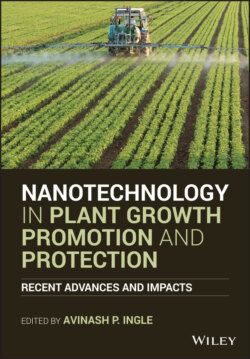Читать книгу Nanotechnology in Plant Growth Promotion and Protection - Группа авторов - Страница 47
3.1 Introduction
ОглавлениеZn nanoparticles (Zn NPs) are among the top three highest produced and utilized engineered nanoparticles (Zhang et al. 2015b). Variations in synthesis methods, such as preparation method, choice of precursors, treatment condition, and treatment duration, affect the properties of synthesized nanoparticles (Kołodziejczak‐Radzimska and Jesionowski 2014). To obtain stability, after synthesis Zn NPs are often undergo a coating process to get the final nanomaterial product. Depending on the shape, size, and aggregation type, the application and effect of nanoparticles vary.
In agriculture, Zn‐related nanomaterials are mostly used as nano‐fertilizer and nano‐pesticide. Zinc cations activate enzymes, such as RNA polymerase, superoxide dismutase (SOD), alcohol dehydrogenase, and carbonic anhydrase; they participate in photosynthesis and metabolism of carbohydrates, lipids, and nucleic acids (Sturikova et al. 2018). Zinc cations facilitate the transcription factors in plants that control the proliferation and differentiation of cells (Palmer and Guerinot 2009). Besides, zinc also controls the development of chloroplasts and some of their functions (Hänsch and Mendel 2009). Zinc deficiency in the plant often causes abnormal plant development and enzyme activity disruption, such as photosynthesis inhibition. In case of an extensive acute deficiency, plants often show dwarf growth and chlorosis (Sharma et al. 2013).
Zn NPs are beneficial because compared to bulk Zn (ZnSO4) they release plant‐available Zn2+ at higher concentration with longer time; therefore, Zn delivery efficiency is higher when applied to Zn in nanoparticle forms (Sturikova et al. 2018). The efficiency of NPs fertilizer or pesticides depends on the size, concentration, surface coatings of the NPs, application method, and the plant species. However, an excess amount of Zn can also be toxic to plants because Zn may compete with other biologically active ions (e.g. Fe2+ and Fe3+) for binding sites in the plant cell (Krämer 2010). Typical symptoms of zinc toxicity include chlorosis of young leaves, the reduction of plant biomass, and inhibition of root growth (Broadley et al. 2007). Therefore, the sustainable use of Zn NPs to promote plant growth is challenging. Considering these facts, the present chapter is aimed to focus on recent advances in the use of Zn NPs in plant growth promotion. Moreover, we believed that systematic studies on interactions between Zn‐based NPs and plants are needed to provide scientific application guidelines in the agricultural system.
